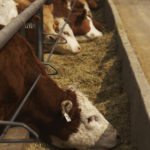
Open Farm Days a sweet deal for everyone, says new participant
Honey producers meet lots of their customers at farmers’ markets but are excited about hosting farm visitors

Alberta’s organic heartland wants to bring more farmers on board
Two-year initiative will assist both existing growers and those wanting to transition to organic production

Alberta Wheat decries pending loss of two popular wheat varieties
AC Muchmore and AAC Redwater will suffer from a price drop when they move to the northern red class

The long decline is over as cow herd finally stabilizes
A lot has changed in the past decade and a half — but what comes next for Alberta’s cattle sector?

Rancher donates $2 million to take beef industry where it ‘needs to go’
Cochrane producer John Simpson says sector is doing a good job in caring for cattle but can do better

Feed additive could be a methane game changer
Feed additive that can halve emissions while boosting feed efficiency is now undergoing a large-scale study

Heritage chicken program at the U of A continues to grow
Program brings heritage genetics into small flocks and supports university’s breeding efforts
VIEW FROM THE NORTH: Small pond, big ripples
There could be some benefits in some areas, but the downsides are many and could seriously disrupt markets

McDonald’s raises the bar — but Canada’s beef industry already there
Fast-food giant wants to slash its carbon footprint, and Canada's beef sector is a model

In a bug-eat-bug world, farmers should help out their insect friends
Beneficial insects are tiny killing machines that can significantly reduce crop pests, says entomologist


